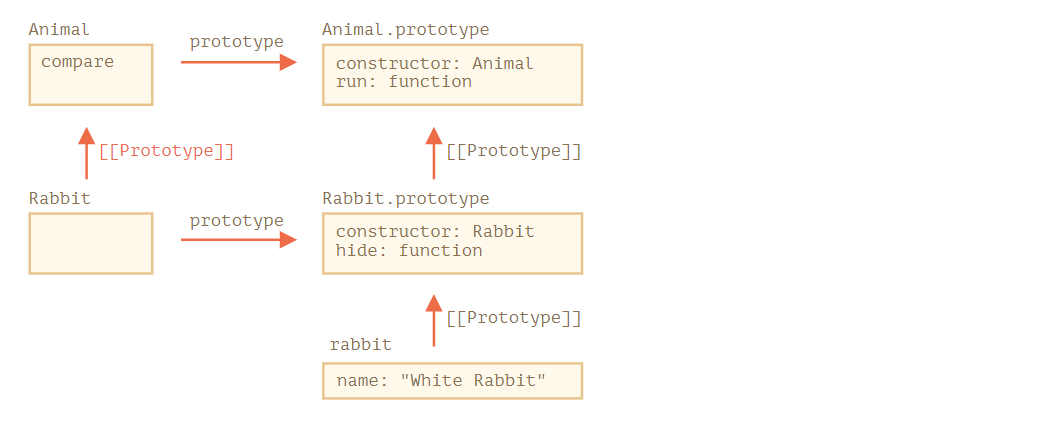 静态属性和静态方法
静态属性和静态方法
我们可以把一个方法赋值给类的函数本身,而不是赋给它的 "prototype"。这样的方法被称为 静态的(static)。
在一个类中,它们以 static 关键字开头,如下所示:
class User {
static staticMethod() {
alert(this === User);
}
}
User.staticMethod(); // true
2
3
4
5
6
7
这实际上跟直接将其作为属性赋值的作用相同:
class User { }
User.staticMethod = function() {
alert(this === User);
};
User.staticMethod(); // true
2
3
4
5
6
7
在 User.staticMethod() 调用中的 this 的值是类构造器 User 自身(“点符号前面的对象”规则)。
通常,静态方法用于实现属于该类但不属于该类任何特定对象的函数。
例如,我们有对象 Article,并且需要一个方法来比较它们。一个自然的解决方案就是添加 Article.compare 方法,像下面这样:
class Article {
constructor(title, date) {
this.title = title;
this.date = date;
}
static compare(articleA, articleB) {
return articleA.date - articleB.date;
}
}
// 用法
let articles = [
new Article("HTML", new Date(2019, 1, 1)),
new Article("CSS", new Date(2019, 0, 1)),
new Article("JavaScript", new Date(2019, 11, 1))
];
articles.sort(Article.compare);
alert( articles[0].title ); // CSS
2
3
4
5
6
7
8
9
10
11
12
13
14
15
16
17
18
19
20
21
这里 Article.compare 代表“上面的”文章,意思是比较它们。它不是文章的方法,而是整个 class 的方法。
另一个例子是所谓的“工厂”方法。想象一下,我们需要通过几种方法来创建一个文章:
- 通过用给定的参数来创建(
title,date等)。 - 使用今天的日期来创建一个空的文章。
- ……其它方法。
第一种方法我们可以通过 constructor 来实现。对于第二种方式,我们可以创建类的一个静态方法来实现。
就像这里的 Article.createTodays():
class Article {
constructor(title, date) {
this.title = title;
this.date = date;
}
static createTodays() {
// 记住 this = Article
return new this("Today's digest", new Date());
}
}
let article = Article.createTodays();
alert( article.title ); // Today's digest
2
3
4
5
6
7
8
9
10
11
12
13
14
15
现在,每当我们需要创建一个今天的文章时,我们就可以调用 Article.createTodays()。再说明一次,它不是一个文章的方法,而是整个 class 的方法。
静态方法也被用于与数据库相关的公共类,可以用于搜索/保存/删除数据库中的条目, 就像这样:
// 假定 Article 是一个用来管理文章的特殊类
// 静态方法用于移除文章:
Article.remove({id: 12345});
2
3
# 静态属性
A recent addition
This is a recent addition to the language. Examples work in the recent Chrome.
最近添加的
这是最近添加的语言,例子工作在最新的
Chrome
静态的属性也是可能的,它们看起来就像常规的类属性,但前面加有 static:
class Article {
static publisher = "Levi Ding";
}
alert( Article.publisher ); // Levi Ding
2
3
4
5
这等同于直接给 Article 赋值:
Article.publisher = "Levi Ding";
# 继承静态属性和方法
静态属性和方法是可被继承的。
例如,下面这段代码中的 Animal.compare 和 Animal.planet 是可被继承的,可以通过 Rabbit.compare 和 Rabbit.planet 来访问:
class Animal {
static planet = "Earth";
constructor(name, speed) {
this.speed = speed;
this.name = name;
}
run(speed = 0) {
this.speed += speed;
alert(`${this.name} runs with speed ${this.speed}.`);
}
static compare(animalA, animalB) {
return animalA.speed - animalB.speed;
}
}
// 继承于 Animal
class Rabbit extends Animal {
hide() {
alert(`${this.name} hides!`);
}
}
let rabbits = [
new Rabbit("White Rabbit", 10),
new Rabbit("Black Rabbit", 5)
];
rabbits.sort(Rabbit.compare);
rabbits[0].run(); // Black Rabbit runs with speed 5.
alert(Rabbit.planet); // Earth
2
3
4
5
6
7
8
9
10
11
12
13
14
15
16
17
18
19
20
21
22
23
24
25
26
27
28
29
30
31
32
33
34
35
36
现在我们调用 Rabbit.compare 时,继承的 Animal.compare 将会被调用。
它是如何工作的?再次,使用原型。你可能已经猜到了,extends 让 Rabbit 的 [[Prototype]] 指向了 Animal。

所以,Rabbit extends Animal 创建了两个 [[Prototype]] 引用:
Rabbit函数原型继承自Animal函数。Rabbit.prototype原型继承自Animal.prototype。
结果就是,继承对常规方法和静态方法都有效。
这里,让我们通过代码来检验一下:
class Animal {}
class Rabbit extends Animal {}
// 对于静态的
alert(Rabbit.__proto__ === Animal); // true
// 对于常规方法
alert(Rabbit.prototype.__proto__ === Animal.prototype); // true
2
3
4
5
6
7
8
# 总结
静态方法被用于实现属于整个类的功能。它与具体的类实例无关。
举个例子, 一个用于进行比较的方法 Article.compare(article1, article2) 或一个工厂(factory)方法 Article.createTodays()。
在类生命中,它们都被用关键字 static 进行了标记。
静态属性被用于当我们想要存储类级别的数据时,而不是绑定到实例。
语法如下所示:
class MyClass {
static property = ...;
static method() {
...
}
}
2
3
4
5
6
7
从技术上讲,静态声明与直接给类本身赋值相同:
MyClass.property = ...
MyClass.method = ...
2
静态属性和方法是可被继承的。
对于 class B extends A,类 B 的 prototype 指向了 A:B.[[Prototype]] = A。因此,如果一个字段在 B 中没有找到,会继续在 A 中查找。
# 实例
# 类扩展自对象?
正如我们所知道的,所有的对象通常都继承自 Object.prototype,并且可以访问“通用”对象方法,例如 hasOwnProperty 等。
例如:
class Rabbit {
constructor(name) {
this.name = name;
}
}
let rabbit = new Rabbit("Rab");
// hasOwnProperty 方法来自于 Object.prototype
alert( rabbit.hasOwnProperty('name') ); // true
2
3
4
5
6
7
8
9
10
但是,如果我们像这样 "class Rabbit extends Object" 把它明确地写出来,那么结果会与简单的 "class Rabbit" 有所不同么?
不同之处在哪里?
下面是此类的示例代码(它无法正常运行 — 为什么?修复它?):
class Rabbit extends Object {
constructor(name) {
this.name = name;
}
}
let rabbit = new Rabbit("Rab");
alert( rabbit.hasOwnProperty('name') ); // Error
2
3
4
5
6
7
8
9
# 解决方案
首先,让我们看看为什么之前的代码无法运行。
如果我们尝试运行它,就会发现原因其实很明显。派生类的 constructor 必须调用
super()。否则"this"不会被定义。下面是修复后的代码:
class Rabbit extends Object { constructor(name) { super(); // 需要在继承时调用父类的 constructor this.name = name; } } let rabbit = new Rabbit("Rab"); alert( rabbit.hasOwnProperty('name') ); // true1
2
3
4
5
6
7
8
9
10但这还不是全部原因。
即便修复了它,
"class Rabbit extends Object"和class Rabbit之间仍存在着重要差异。我们知道,“extends” 语法会设置两个原型:
- 在构造函数的
"prototype"之间设置原型(为了获取实例方法)。- 在构造函数之间会设置原型(为了获取静态方法)。
在我们的例子里,对于
class Rabbit extends Object,它意味着:class Rabbit extends Object {} alert( Rabbit.prototype.__proto__ === Object.prototype ); // (1) true alert( Rabbit.__proto__ === Object ); // (2) true1
2
3
4所以,现在
Rabbit可以通过Rabbit访问Object的静态方法,像这样:class Rabbit extends Object {} // 通常我们调用 Object.getOwnPropertyNames alert ( Rabbit.getOwnPropertyNames({a: 1, b: 2})); // a,b1
2
3
4但是如果我们没有
extends Object,那么Rabbit.__proto__将不会被设置为Object。下面是示例:
class Rabbit {} alert( Rabbit.prototype.__proto__ === Object.prototype ); // (1) true alert( Rabbit.__proto__ === Object ); // (2) false (!) alert( Rabbit.__proto__ === Function.prototype ); // true,所有函数都是默认如此 // error,Rabbit 中没有这样的函数 alert ( Rabbit.getOwnPropertyNames({a: 1, b: 2})); // Error1
2
3
4
5
6
7
8所以,在这种情况下,
Rabbit没有提供对Object的静态方法的访问。顺便说一下,
Function.prototype有一些“通用”函数方法,例如call和bind等。在上述的两种情况下它们都是可用的,因为对于内建的Object构造函数而言,Object.__proto__ === Function.prototype。我们用一张图来解释:
所以,简而言之,这里有两点区别:

